Related Research Articles

Christopher Lee Burden was an American artist working in performance art, sculpture and installation art. Burden became known in the 1970s for his performance art works, including Shoot (1971), where he arranged for a friend to shoot him in the arm with a small-caliber rifle. A prolific artist, Burden created many well-known installations, public artworks and sculptures before his death in 2015.

The Los Angeles County Museum of Art (LACMA) is an art museum located on Wilshire Boulevard in the Miracle Mile vicinity of Los Angeles. LACMA is on Museum Row, adjacent to the La Brea Tar Pits.
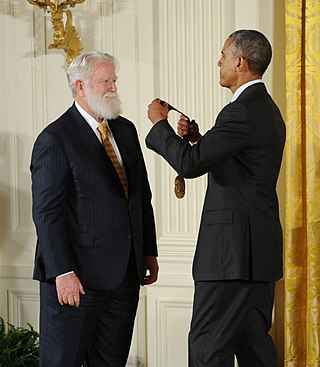
James Turrell is an American artist known for his work within the Light and Space movement. Much of Turrell's career has been devoted to a still-unfinished work, Roden Crater, a natural cinder cone crater located outside Flagstaff, Arizona, that he is turning into a massive naked-eye observatory; and for his series of skyspaces, enclosed spaces that frame the sky.

The Museum of Contemporary Art San Diego, in San Diego, California, US, is an art museum focused on the collection, preservation, exhibition, and interpretation of works of art from 1950 to the present.
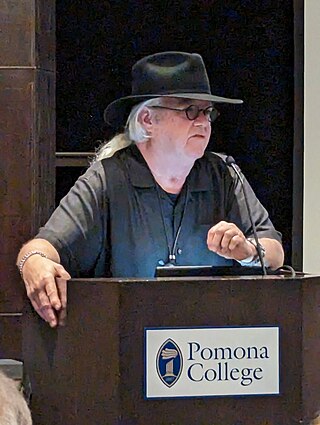
Peter Shelton is a contemporary American sculptor born in 1951 in Troy, Ohio.

David Maupin is an American art dealer.
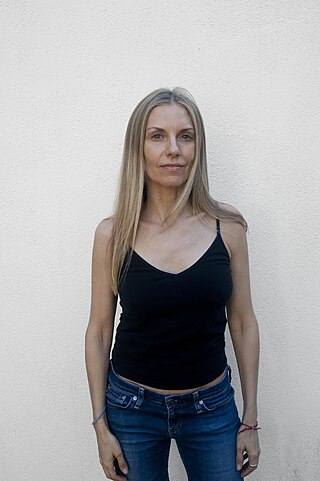
Liza Lou is an American visual artist. She is best known for producing large scale sculpture using glass beads. Lou ran a studio in Durban, South Africa from 2005 to 2014. She currently has a nomadic practice, working mostly outdoors in the Mojave Desert in southern California. Lou's work is grounded in domestic craft and intersects with the larger social economy.

Light and Space denotes a loosely affiliated art movement related to op art, minimalism and geometric abstraction originating in Southern California in the 1960s and influenced by John McLaughlin. It is characterized by a focus on perceptual phenomena, such as light, volume and scale, and the use of materials such as glass, neon, fluorescent lights, resin and cast acrylic, often forming installations conditioned by the work's surroundings. Whether by directing the flow of natural light, embedding artificial light within objects or architecture, or by playing with light through the use of transparent, translucent or reflective materials, Light and Space artists make the spectator's experience of light and other sensory phenomena under specific conditions the focus of their work. From the movement's inception, artists were incorporating into their work the latest technologies of the Southern California-based engineering and aerospace industries to develop sensuous, light-filled objects. Turrell, who has spread the movement worldwide, summed up its philosophy in saying, "We eat light, drink it in through our skins."
Lita Albuquerque is an American installation, environmental artist, painter and sculptor. She is a part of the core faculty in the Graduate Fine Art Program at Art Center College of Design.

Rupert Deese was an American ceramic artist. He is known for innovative design and decoration of high fired ceramics. Deese wrote "It is my hope in making these vessels that as the perception of their beauty diminishes over time, they will sustain themselves by pleasant usefulness."
Urban Light (2008) is a large-scale assemblage sculpture by Chris Burden located at the Wilshire Boulevard entrance to the Los Angeles County Museum of Art (LACMA). The 2008 installation consists of restored street lamps from the 1920s and 1930s. Most of them once lit the streets of Southern California.

Alex Prager is an American artist, director, and screenwriter based in Los Angeles.
Analia Saban is a contemporary conceptual artist who was born in Buenos Aires, Argentina, but is currently living in Los Angeles, California, United States. Her work takes traditional artistic media such as drawing, painting and sculpture and pushes their limits as a scientific experimentation with art making. Because of her pushing the limits with different forms of art, Saban has taken the line that separated the different art forms and merged them together.
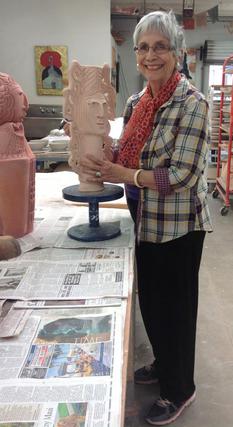
Dora De Larios was an American ceramist and sculptor working in Los Angeles. She was known for her work's clean lines and distinctive glazes, as well as for her line of tableware created under her family-run company Irving Place Studio. Also a muralist working with tile, De Larios was noted for her style, which reflects mythological and pan-cultural themes.

Gisela Colon is an American international contemporary artist who has developed a unique vocabulary of Organic Minimalism, breathing lifelike qualities into reductive forms. Operating at the intersection of art and science, Colon is best known for meticulously creating light-activated sculptures through industrial and technological processes. Drawing from aerospace and other scientific realms, Colon utilizes innovative sculptural materials such as carbon fiber and optical materials of the 21st century, to generate her energetic sculptures. Colon's gender-fluid sculptures disrupt the traditional view of the masculine minimal object, by embodying qualities of energy, movement and growth, through a merger of industrial with the organic.

Jeon Joonho is a South Korean artist.
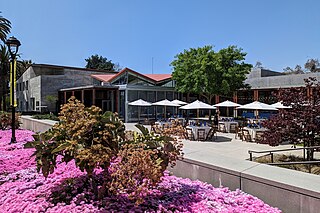
The Benton Museum of Art at Pomona College, known colloquially as the Benton, is an art museum at Pomona College in Claremont, California. It was completed in 2020, replacing the Montgomery Art Gallery, which had been home to the Pomona College Museum of Art (PCMA) since 1958. It houses a collection of approximately 19,000 items, including Italian Renaissance panel paintings, indigenous American art and artifacts, and American and European prints, drawings, and photographs. The museum is free to the public.

Joe Ray is an American artist based in Los Angeles. His work has moved between abstraction and representation and mediums including painting, sculpture, performance art and photography. He began his career in the early 1960s and belonged to several notable art communities in Los Angeles, including the Light and Space movement; early cast-resin sculptors, including Larry Bell; and the influential 1970s African-American collective, Studio Z, of which he was a founding member with artists such as David Hammons, Senga Nengudi and Houston Conwill. Critic Catherine Wagley described Ray as "an artist far more committed to understanding all kinds of light and space than to any specific material or strategy"—a tendency that she and others have suggested led to his being under-recognized.
Esteban Ramón Pérez is an American artist who produces multi-media paintings and sculptures. His sociopolitical artwork often emphasizes subjective memory, spirituality, and fragmented history. Pérez earned a BFA from the California Institute of the Arts in 2017 and an MFA in painting and printmaking from the Yale School of Art, New Haven, Connecticut, in 2019. Pérez’s work has been exhibited in numerous group exhibitions, including shows at Artspace, New Haven, Connecticut; Eastern Connecticut State University Art Gallery, Windham, Connecticut; Transmitter Gallery, Brooklyn; James Cohan Gallery, New York; Gamma Galería, Guadalajara, Mexico; Calderón, New York; the Arlington Arts Center, Virginia; Charles Moffett, New York; and Lehmann Maupin, New York. Solo exhibitions include Staniar Gallery, Lexington, Virginia. Pérez was selected for the NXTHVN Fellowship Program and is a 2022 recipient of the Artadia Award. He lives and works in Los Angeles, California.
Calida Garcia Rawles is a Los Angeles-based contemporary visual artist. In her large-scale paintings and murals, Rawles merges hyperrealism and abstraction. The artist is interested in questions of identity and race in relation to Western art history. Her portraits often depict representations of water and Black life. She is a practicing artist and a mother.
References
- 1 2 3 4 Vankin, Deborah (29 March 2014). "Artist Helen Pashgian brings her love of light to LACMA's space". Los Angeles Times . Archived from the original on 26 August 2023. Retrieved 9 May 2014.
- ↑ Kennedy, Randy (15 September 2011). "Reputation and Monolith, Both Stand Tall" . The New York Times . Archived from the original on 9 September 2012. Retrieved 24 January 2024.
- 1 2 Duncan, Michael (11 September 2010). "Helen Pashgian". Art in America . Archived from the original on 21 July 2012. Retrieved 24 January 2024.
- 1 2 3 "Helen Pashgian - Biography". Totah. Archived from the original on 8 June 2019. Retrieved 9 January 2018.
- 1 2 3 "Helen Pashgian: Light Invisible". Los Angeles County Museum of Art . 2014. Archived from the original on 20 March 2023. Retrieved 24 January 2024.
- ↑ "Pacific Standard Time at the Getty Center: Helen Pashgian". Getty Center . Archived from the original on 9 February 2023. Retrieved 24 January 2024.
- ↑ Bocicault, Miabelle (11 February 2014). "Interview: Helen Pashgian Describes the Power of Her New, Glowing Sculptures for 'Light Invisible' at LACMA". Complex . Archived from the original on 5 August 2023. Retrieved 9 May 2014.
- ↑ "Light and Space art". Museum of Contemporary Art, Los Angeles . Archived from the original on 21 June 2015. Retrieved 9 May 2014.
- 1 2 Landi, Ann (20 December 2021). "'Helen Pashgian: Presences' Review: Maker of Luminous Objects: California Light and Space artist Helen Pashgian finally gets her moment in the sun" . The Wall Street Journal . ProQuest 2611751632. Archived from the original on 5 January 2022. Retrieved 24 January 2024.
- ↑ Pagel, David (17 April 2014). "Review: At LACMA's 'Helen Pashgian,' step back and watch magic happen" . Los Angeles Times . Archived from the original on 16 November 2022. Retrieved 29 October 2022.
- ↑ Avgikos, Jan (March 2022). "Helen Pashgian". Artforum . 60 (7). Archived from the original on 21 September 2023. Retrieved 29 October 2022.
- ↑ "The Senses: Selections from the Permanent Collection". Pomona Museum . 2006. Archived from the original on 16 November 2022. Retrieved 16 November 2022.
- 1 2 3 4 5 6 7 8 9 10 11 12 13 14 15 16 17 18 "Artists - Helen Pashgian - Biography". Lehmann Maupin . Archived from the original on 30 August 2023. Retrieved 29 October 2022.
- ↑ "Translucence: Southern California Art from the 1960s & 1970s". Norton Simon Museum . 2006. Archived from the original on 31 July 2023. Retrieved 16 November 2022.
- ↑ "Primary Atmospheres: Works from California 1960-1970". David Zwirner Gallery . 2010. Archived from the original on 30 August 2023. Retrieved 16 November 2022.
- ↑ "Exhibition: Phenomenal: California Light, Space, Surface". Museum of Contemporary Art San Diego . 2011–2012. Archived from the original on 2 April 2023. Retrieved 16 November 2022.
- ↑ "Pacific Standard Time: Crosscurrents in L.A. Painting and Sculpture, 1950–1970". Pacific Standard Time at the Getty. J. Paul Getty Museum. 2011–2012. Archived from the original on 2 April 2023. Retrieved 16 November 2022.
- ↑ "Beyond Brancusi: The Space of Sculpture". Norton Simon Museum . 2013–2014. Archived from the original on 30 July 2023. Retrieved 16 November 2022.
- ↑ "Water and Light". Ochi Gallery. 2018. Archived from the original on 16 November 2022. Retrieved 16 November 2022.
- ↑ "Hayward Gallery - Space Shifters". Southbank Centre . 2018–2019. Archived from the original on 16 November 2022. Retrieved 16 November 2022.
- ↑ "Crystals in Art: Ancient to Today". Crystal Bridges Museum of American Art . 2019–2020. Archived from the original on 8 July 2023. Retrieved 16 November 2022.
- ↑ "Light & Space - Exhibition". Copenhagen Contemporary. 2021. Archived from the original on 25 March 2023. Retrieved 16 November 2022.
- ↑ "Special Exhibition: Beyond the Light of East and West". Korean Cultural Center, Los Angeles. 2021. Archived from the original on 17 April 2021. Retrieved 24 January 2024.
- ↑ "Light, Space, Surface: Works from the Los Angeles County Museum of Art". Addison Gallery of American Art . 2021. Archived from the original on 25 January 2024. Retrieved 16 November 2022.
- ↑ "Helen Pashgian: Working in Light". Pomona Museum . 2010. Archived from the original on 16 November 2022. Retrieved 16 November 2022.
- ↑ "New Lenses and Spheres". Artforum . 2019. Archived from the original on 16 November 2022. Retrieved 16 November 2022.
- ↑ "Lehmann Maupin - Exhibitions - Helen Pashgian". Ocula. 2019–2020. Archived from the original on 16 January 2021. Retrieved 24 January 2024.
- ↑ Straus, Michael (February 2020). "Helen Pashgian with Michael Straus". The Brooklyn Rail . Archived from the original on 28 December 2022. Retrieved 24 January 2024.
- ↑ "Helen Pashgian: Primavera". Benton Museum of Art . 2021–2022. Archived from the original on 10 June 2023. Retrieved 16 November 2022.
- ↑ "Exhibition - Helen Pashgian: Presences". SITE Santa Fe . 2021–2022. Archived from the original on 2 June 2023. Retrieved 29 October 2022.
- ↑ Brooks, Katherine (12 August 2013). "L.A. Museum Honors Female Artists With Distinguished Women In The Arts Award". HuffPost . Archived from the original on 25 January 2024. Retrieved 9 May 2014.
- ↑ "Pomona College taps five new board members". San Gabriel Valley. Los Angeles Times . 2 August 1987. p. 5. Archived from the original on 25 January 2024. Retrieved 5 July 2021– via Newspapers.com.
- ↑ Edelson, Mary Beth (1972). "Some Living American Women Artists/Last Supper". Smithsonian American Art Museum (Photo of lithograph). Archived from the original on 31 March 2023. Retrieved 21 January 2022.
22. Helen Pashgian